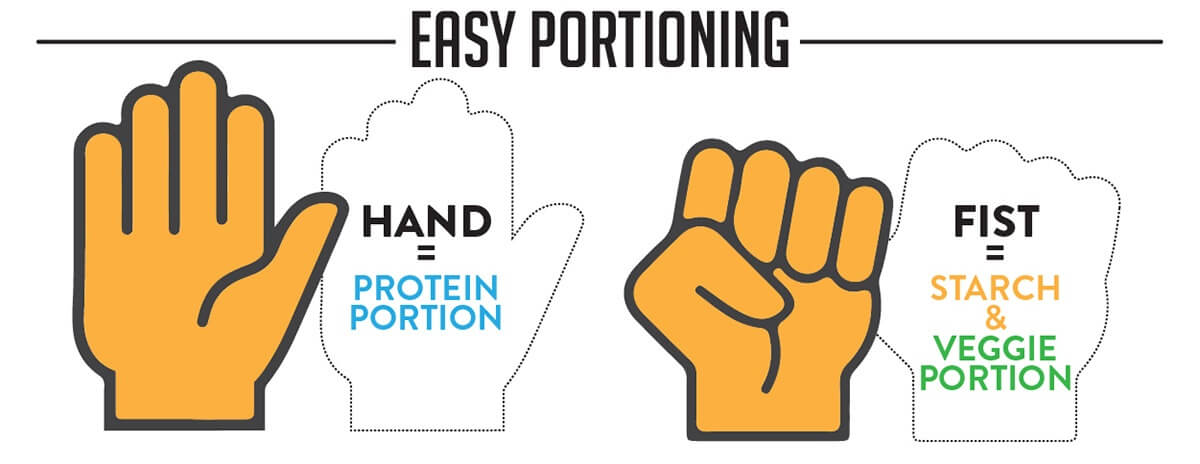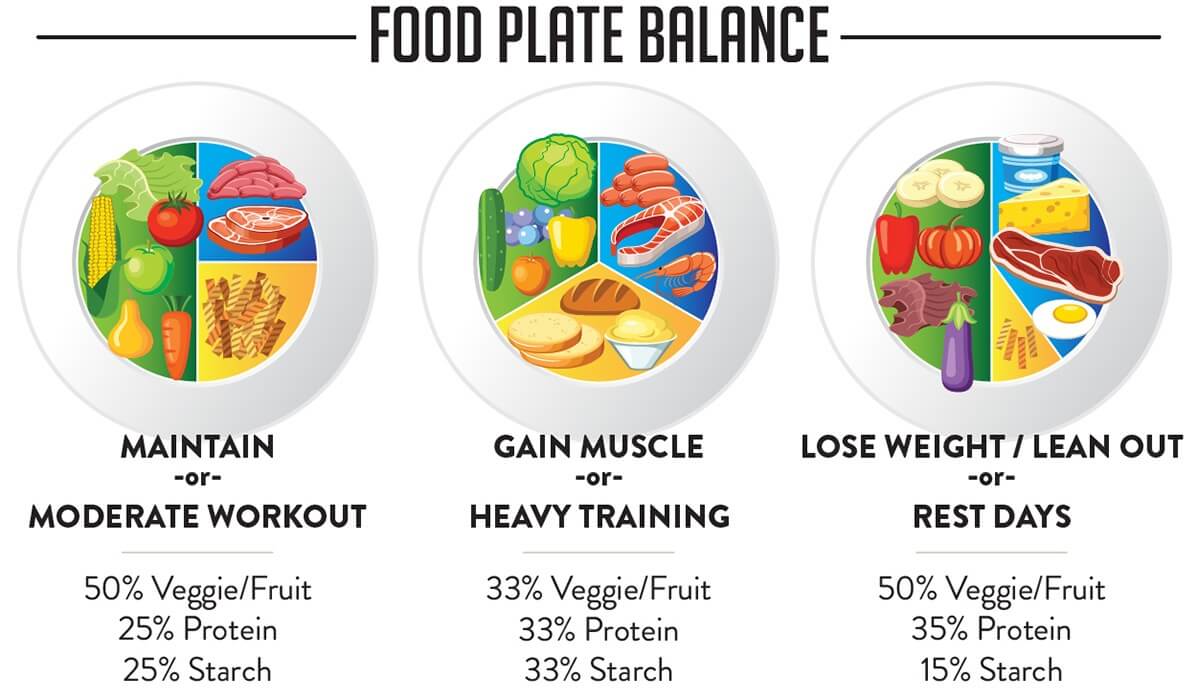Nutrition Made Easy. How to Count Your Macros.

Whether you have been counting macronutrients or “macros” for a while or are getting started, at some point you may find yourself without a food scale, meal plan template or tracking app and you will find the need to guesstimate how much food to put on your plate. Or maybe you just want the fastest way possible to balance your portions and stay on track. Well, good news. You have your own portion control device in the palm of you hand already… your hand!
How To Quickly Portion My Food?
The size of your hand is unique and closely aligns with your serving size requirements – the bigger your hand, the more food you need. Hold your hand up and look at your palm. One full hand is a single serving of protein. Now make a fist, one fist is a single serving of starches, and 2 fists is a standard serving of veggies.

Use Your Hand as Your Portioning Guide.
Customize Your Food Portions to Your Needs
The portion plate you use may change from day to day or from meal to meal, depending on your nutrition goals. You can adjust your proteins and carbs based on how active you will be that day, eating more food when you are more active and a lighter meal when you are less active.

Carbohydrate needs are directly related to your level of physical activity. Eat more carbohydrates when you are the most active.
Protein needs are directly related to lean body mass. You should get at least 1g of protein per 1 pound of lean body mass. Structuring your meals to fill 1/4th to 1/3rd of your plate with high quality protein will give you about 30-40 grams per meal, and enough to meet your needs.
The type of activity you are doing can also affect your macro needs. Heavy lifting and high intensity training will require more carbs and a little more protein, compared to moderate activity when you might not need to adjust your carbs at all.
Different Types of Foods
Learning your unique portions and counting macros without supporting tools, does require you to comprehend basic nutrition, or at least know what is considered a carb, protein and fat. Here is a quick breakdown to get you started.
What Foods Count as a Carb?
Carbohydrates are sugars, fibers and starches, and come from anything that grows out of the ground, and dairy.
This includes fruits, vegetables, beans, legumes and grains. As well as milk and yogurt. Carbohydrates also come from added and naturally occurring sugars like table sugar, honey, maple syrup, etc. But this does not include artificial sweeteners. Here is a summarized list of carbohydrate foods or starchy foods you may be eating:
- Peas, Corn, Potatoes
- Fruit
- Beans, Lentils, and Peas
- Quinoa, Polenta, Bulgur, Farro, Barley, Spelt, Oats, Buckwheat
- Black Rice, Red Rice, Brown Rice, Wild Rice and White Rice
- Breads, Rolls, and Tortillas
- Noodles, Pasta, and Gnocchi
- Cereal
- Granola Bars
- Milk, Yogurt
- Crackers, Pretzels, Popcorn and Chips
What Foods Count as Veggies?
Vegetables can be broken up into two types: starchy and non-starchy. The starchy vegetables would fall under the carb section of the plate, while non-starchy are not significantly high in carbs, protein or fat, and have their own section. Non-starchy veggies are mostly water. They provide few calories and are the highest in nutrient density, meaning your can eat a lot more for a lot less calories. Eating more veggies will help make sure your micronutrient intake is up to par! Not to mention veggies are typically high in fiber that will keep you feeling super satisfied.
| Starchy Veggies | Non-Starchy Veggies |
|
|
What Foods Count as a Protein?
There are 8 types of protein that are made up of amino acids. Protein mostly comes from meat, dairy and plant-based sources. Beef up on protein to curb your appetite, stimulate your metabolism, and keep your energy levels high. Look for a variety of protein sources to lock in more nutrition and don’t forget to get a good source of omega-3s from seafood two to three times per week. Some superfoods contain protein and there are foods with a surprising amount of protein per gram. Here is a summarized list of proteins broken down by animal, veggie and vegan protein types that you may be eating:
- High Omega-3 Fish (Ex: Wild Caught Salmon, Arctic Char, Atlantic Mackerel, Sardines, Sablefish/Black Cod, Anchovies, Rainbow Trout, Albacore Tuna, and Pacific Halibut)
- Other Fish like Tilapia and Tuna
- Poultry (Ex: Chicken, Turkey, Quail, Game Hen)
- Oysters, Mussels and Clams
- Whey or Casein Protein Powder
- Non-fat Greek Yogurt
- Eggs
- Milk (also a starch)
- Low-fat Cheese (also a fat)
- Edamame, Soy Beans, Beans, and Lentils (also a starch)
- Nuts and Nut Butters (also a fat)
- Tofu, and meat substitutes (also a starch)
- Pea, Hemp, Brown Rice or Soy Protein Powder
- Quinoa, Kamut, and Whole Grain Pasta (also a starch)
Veggie
Vegan
What Food Count As Fatty Foods?
Fats are not included as a portion in the plate because fat typically acts as a topping or extra ingredient. If you are trying to gain weight, fats are an easy way to add calories without adding a lot of volume. But if you are leaning out they should be kept moderate but not totally eliminated since there are harmful effects of too little fat. Here are some common ways you can add fat to your plate:
- Avocado
- Flax Seeds, Sesame Seeds, Chia Seeds and Pumpkin Seeds
- Walnuts, Almonds, Pistachios, Peanuts, Cashews, Pecans, Macadamia, and other Nuts and Nut Butters
- Olive Oil, Sesame Oil, Coconut Oil, Hazelnut Oil, Flaxseed Oil, Avocado Oil, Pistachio Oil, and Other Cooking Oils
- Butter
- Beef Tallow
- Lard
If your food is cooked with fat or naturally contains fat like from olives, avocado or nuts, you probably do not need to add any additional fat. But if you are eating very lean meats, steamed veggies and plain starches, you may want to add a little fat for flavor and satiety.